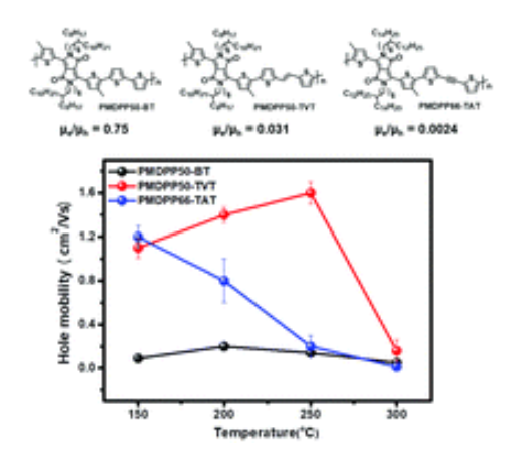Effect of donor units in methylated DPP-based polymers on performance of organic field-effect transistors
- 저자
- Hee Su Kim, Dang Long, Yong-Young Noh*, Do-Hoon Hwang*
- 저널명
- Journal of Materials Chemistry C, 6, 10464-10471 (2018)
- 년도
- 2018
- Link
- https://doi.org/10.1039/C8TC02319K 498회 연결
[Abstract]
A series of new donor–acceptor copolymers containing methylated diketopyrrolopyrrole (MDPP) was synthesized for the active layer of organic field-effect transistors (OFETs) through Stille cross-coupling with various donor units including bithiophene (PMDPP50-BT), thienylene–vinylene–thienylene (PMDPP50-TVT), and thienylene–acetylene–thienylene (PMDPP66-TAT). The performance of the OFETs strongly depended on which donor unit was copolymerized with MDPP. The PMDPP50-BT OFETs exhibited a well-balanced hole and electron mobility of 0.2 ± 0.04 and 0.15 ± 0.04 cm2 V−1 s−1, respectively, even though their absolute mobility values were the lowest due to their high crystalline randomness and poor conjugated backbone planarity. By changing the donor unit from BT to the larger-sized TVT or TAT, both the PMDPP50-TVT and PMDPP66-TAT OFETs showed significantly improved hole mobilities of 1.6 ± 0.1 and 1.25 ± 0.1 cm2 V−1 s−1, respectively, due to their more extended backbone planarity and well-developed edge-on orientation. However, the electron mobilities of the PMDPP50-TVT and PMDPP66-TAT OFETs degraded to 0.05 and 0.003 cm2 V−1 s−1, respectively, because of their relatively high lowest unoccupied molecular orbital energy levels resulting in poor electron injection properties.
